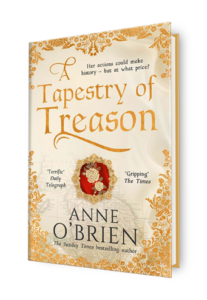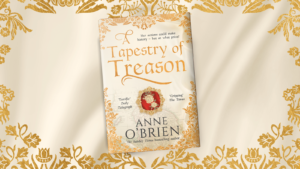A Tapestry of Treason
First a few thoughts on the probably/possible marriage of Constance of York to Edmund Earl of Kent. So much intrigue here to conjure with.
After the death of her husband Thomas, Lord Despenser, there is historical evidence that Constance had an affair with Edmund Holland, a young man of the notorious Holland family, fighting to gain restoration of his position at the Court of King Henry IV after the usurpation and death of Richard II. A man of some ambition, like most of the Hollands, he worked hard to reclaim his estates, his income and his title. As most ambitious aristocracy of the day, he had an eye to promotion and royal patronage.
And he had an affair with the newly widowed Constance, now stripped of her titles, her estates, her dower and her wealth. As a consequence of the affair, an illegitimate daughter, Alianore (Eleanor), was born in about 1406.
Yet after Constance’s treacherous involvement in the Mortimer plot of 1405 and her imprisonment in Kenilworth Castle at the King’s pleasure, Edmund Holland, now Earl of Kent, abandoned her. WAs she too dangerous a woman to associate with, if he had ambitions to increase his in fluence at Court? A marriage was arranged for him, with the backing of King Henry, to Lucia Visconti, daughter of the Lord of Milan, a lady somewhat older than Edmund but with an impressive dowry. They were married at the Church of St Mary Overie in Southwark in 1406, a ceremony which Constance possibly attended. She made no response to this marriage, making no statement of interest in it.
Was there a marriage prior to this Visconti alliance between Constance and Edmund? There is no concrete evidence, sadly.
If there is no direct evidence, why do I pose the question over a possible legal marriage between them?
– Edmund died in 1408 with no direct heirs. Alianore, the ‘illegitimate’ daughter with Constance, who married James Tuchet, Lord Audley, was later to claim that she was in fact the legitimate daughter of Constance and Edmund, and so as his only direct heir, deserved her Holland inheritance. Her claim was ignored by the Hollands who closed ranks against her, but that does not necessarily mean that it was not a genuine claim on the inheritance. The Holland inheritance was divided between the rest of the living Holland family, who had every financial reason to reject Alianore.
– there was family experience of clandestine marriages which Edmund Holland must have been aware of. This was the exchange of vows between two people who desired marriage, making a personal commitment in plain words, without a priest or religious ceremony, but with two witnesses, to make it legal. The Church frowned on it but could not deny that such a marriage had legs. Edmund’s grandmother Joan, Countess of Kent had engaged in just such a marriage with Sir Thomas Holland without her family’s consent. The pope had declared it legal and her subsequent marriage to the Earl of Salisbury thus bigamous. Was Edmund willing to follow this example, because he wished to wed Constance? Had they exchanged private, clandestine vows?
-If a marriage had taken place, why did Constance not claim the Visconti wedding to be a false one? After her imprisonment for treason, perhaps she had come to think that it might not be politically wise to do so. Both Edmund and King Henry wanted the Italian connection. Let sleeping dogs lie.
We will never know the answer. Edmund died in 1408 from the bolt of a crossbow in a campaign against Brittany. The Visconti dowry was never forthcoming. Constance did not marry again and retired very much from public life.
But there is always that element of possibility – that Constance and Edmund married and that Alianore was a legitimate Holland daughter. And because I write historical fiction, such a presumption is fair game for my pen.
Enjoy all the family complications in A Tapestry of Treason.


